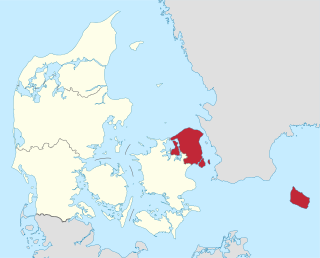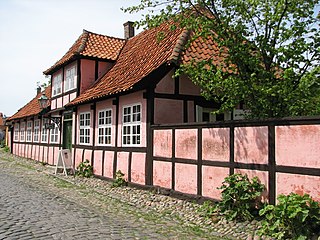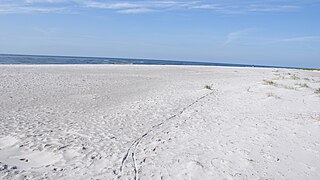
Ertholmene is a small archipelago situated 19 kilometres (12 mi) northeast of Gudhjem, Bornholm and 27 kilometres (17 mi) east of Allinge-Sandvig in the Baltic Sea. It is 106 miles (171 km) southeast of the capital of Denmark, Copenhagen. Its name derives from the Danish for "pea islands".

Hasle is a town and a former municipality on the west coast of the Baltic island of Bornholm, Denmark. Its population is 1,638 The former municipality covered an area of 115 km2 (44 sq mi), and had a total population of 6,382. It is now included in the municipality of Bornholm. With its pleasant setting, smokehouses, galleries and harbour, the town attracts many tourists.

Nexø, sometimes spelled Neksø, is a town on the east coast of the Baltic island of Bornholm, Denmark. With a population of 3,644, it is the second largest town, as well as the largest fishing port on the island. Fishing is the mainstay of the town's economy. Nexø is also the site of a distillery and a mustard factory. The town is also a port of call for the passenger ferries linking Bornholm with Kołobrzeg, Darłowo, and Ustka in Poland. Dueodde, the largest beach on Bornholm, is located south of Nexø, in the southeastern corner of the island.

Rønne is the largest town on the Danish island of Bornholm in the Baltic Sea. It has a population of 13,579. Once a municipality in its own right from 1970 until 2002, when Bornholm was a county with an area of 29.11 square kilometres, it is now the administrative centre of the Bornholm municipality. As of 2018 11,539 inhabitants live in Rønne Parish, which is a narrow piece of land on the westernmost of the island and stretching north and southward comprising around a third of the area of the former municipality. Knudsker Parish made up the rest of the former municipality. Not all inhabitants of either Rønne or Knudsker (400-7553) parishes live in the city of Rønne.

The Capital Region of Denmark is the easternmost administrative region of Denmark, established on January 1, 2007 as part of the 2007 Danish Municipal Reform, which abolished the traditional counties and set up five regions. At the same time, smaller municipalities were merged into larger units, cutting the number of municipalities from 271 before 1 January 2006, when Ærø Municipality was created, to 98. The Capital Region has 29 municipalities. The reform was implemented on January 1, 2007. The main task for the Danish regions are hospitals and healthcare. It is not to be confused with the Copenhagen Metropolitan Area nor with the Øresund Region. Unlike the counties (1970-2006) the regions are not municipalities and are thus not allowed to have coat of arms, but only logotypes, and cannot "shuffle money around" from one area of expenditure to another area of expenditure, that is, use money for any other purpose than has been stated specifically, but must pay money not used back rather like departments or agencies of the central government. The regions do not levy any taxes but are financed only through block grants.

Allinge-Sandvig is a small town on the northern coast of the Baltic island of Bornholm, Denmark. Its population is 1,582. It was part of the former municipality Allinge-Gudhjem. Sandvig is the northernmost part of the town.

The Bornholm Art Museum is situated on the Danish island of Bornholm, above the Sanctuary Rocks (Helligdomsklipperne) about 6 kilometres north-west of Gudhjem. The building was constructed in 1993 and enlarged in 2003. The museum's permanent collection consists principally of paintings by artists with connections to Bornholm from the early 19th century to the present day. Special attention is given to the Bornholm school of painters which emerged at the beginning of the last century when a number of modernists, attracted to picturesque Bornholm and the tiny island of Christiansø, painted landscapes and local nature.

Tejn is a harbour town on the north-eastern coast of the Danish island of Bornholm, 5 km (3.1 mi) south of Allinge-Sandvig. As of 1 January 2014, it has a population of 959. Initially a fishing village, it grew considerably during the 20th century as the harbour was enlarged on several occasions. The local fishing industry reached its peak in the 1970s and 1980s but has since decreased, with negative implications for the town's activities.

Erichsens Gård is Rønne's best kept commoner's house and is now part of the Bornholm Museum.

Vestermarie Church is located in the little village of Vestermarie some 8 km east of Rønne on the Danish island of Bornholm. The present Neo-Romanesque church replaces a now demolished 14th-century building.

Almindingen is one of the largest forests in Denmark. It is located in the centre of the island of Bornholm. The forest covers 3,800 hectares, making it Denmark's third largest. Though it was at one time common grazing land for cattle, it was fenced in for forestry in 1809 by Hans Rømer, the forest supervisor. As a result, by the beginning of the 20th century, Bornholm had become Denmark's most forested region.

Hammeren is a protected area and promontory in Denmark on the northernmost point of Bornholm island. It projects into Sæne Bugt bay in the Baltic Sea. The area includes Hammersø, the largest lake on the island and the only tarn in Denmark, and a hill, 276 feet (84 m) in height, named Stejlebjerg. It is steep to the southwest but slopes gradually to the northeast, and is separated from the rest of the land by a valley.

Dueodde is a beach in Denmark on Bornholm's southernmost tip. It is known for its very fine white sand. The area around Dueodde was originally a large sandy area. In the eighteenth century it was planted with pines, as well as Ammophila and Leymus grasses to reduce sand drift. Today, Dueodde is a protected area. The sand at Dueodde moves easily with the wind to form dunes. The vast dune area and associated sandy beach start at Haslemere extending some 30 kilometres (19 mi) almost without interruption. Apart from the beach, one noteworthy feature is the Dueodde Lighthouse on the southern tip. It is the tallest on the island. Built in 1962, it offers a panoramic view of the surroundings. The two old lighthouses, Dueodde Syd and Dueodde Nord are not open for the public.

Tejn Mølle, also known as Melsted Stubmølle, is a post mill on the Danish island of Bornholm. It was recently moved from Tejn on the west coast to Melstedgård near Gudhjem where it is part of Bornholms Landbrugsmuseum.

Svanemøllen is a wooden smock mill located just west of Svaneke on the Danish island of Bornholm. Built in 1857, it remained in service until the 1950s. Since 1960, it has been a listed building.

Vestermarie is a village midway between Rønne and Aakirkeby on the Danish island of Bornholm. As of 2014, it has a population of 245.

Gryet, some 4 kilometres (2.5 mi) west of Nexø and just north of Bodilsker on the Danish island of Bornholm, is a site with one of Denmark's largest collections of megaliths with tall upright stones standing among the trees in a little wood.
Protected areas of Denmark comprise a number of various current designations across Denmark proper, including Natura 2000, EU habitats areas and Ramsar areas.




















